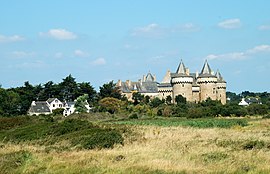Sarzeau (French pronunciation: [saʁzo]; Breton: Sarzhav) is a commune in the Morbihan department of Brittany in north-western France.[3]
Sarzeau
Sarzhav | |
|---|---|
 Suscinio Castle | |
| Coordinates: 47°31′41″N 2°46′07″W / 47.5281°N 2.7686°W | |
| Country | France |
| Region | Brittany |
| Department | Morbihan |
| Arrondissement | Vannes |
| Canton | Séné |
| Intercommunality | Golfe du Morbihan - Vannes Agglomération |
| Government | |
| • Mayor (2021–2026) | Jean-Marc Dupeyrat[1] |
| Area 1 | 60.23 km2 (23.25 sq mi) |
| Population (2021)[2] | 8,977 |
| • Density | 150/km2 (390/sq mi) |
| Time zone | UTC+01:00 (CET) |
| • Summer (DST) | UTC+02:00 (CEST) |
| INSEE/Postal code | 56240 /56370 |
| Elevation | 0–42 m (0–138 ft) |
| 1 French Land Register data, which excludes lakes, ponds, glaciers > 1 km2 (0.386 sq mi or 247 acres) and river estuaries. | |
It is located on the Rhuys peninsula between the Gulf of Morbihan and the Atlantic Ocean.
History
editThe area around the Morbihan has been occupied since neolithic times. Prehistoric monuments remaining include the menhirs of Kermaillard and Largueven, as well as the dolmens of Kergillet and Brillac. The town itself was first mentioned in the 11th century in reference to an abbey at the site [1]. The nearby Château de Suscinio was built in the 13th century and fortified in the 15th century. The castle was a favorite spot of the Dukes of Brittany who often came for the hunting in the surrounding region [2]. During the Middle Ages, because of its size the town was divided into seven local divisions, a situation that still exists to some extent. The town officially became a commune during the French Revolution.
Sarzeau was the birthplace of Alain-René Lesage (1668–1747), the author of novel The Devil upon Two Sticks (1707), his comedy Turcaret (1709) and his picaresque novel Gil Blas, (1715–1735).[4]
Population
editInhabitants of Sarzeau are called in French Sarzeautins.
| Year | Pop. | ±% p.a. |
|---|---|---|
| 1968 | 3,676 | — |
| 1975 | 4,088 | +1.53% |
| 1982 | 4,406 | +1.08% |
| 1990 | 4,972 | +1.52% |
| 1999 | 6,143 | +2.38% |
| 2007 | 7,330 | +2.23% |
| 2012 | 7,710 | +1.02% |
| 2017 | 8,182 | +1.20% |
| Source: INSEE[5] | ||
Sights
edit- The Château de Suscinio is a 13th-century castle that has recently been restored. Inside there is also a museum on the history of the area.
- The Château de Kerlevenan is an 18th-century castle with large gardens.
- Museum of Arts et Métiers and Cider Museum.
- Menhirs of Kermaillard and Largueven, and the dolmens of Kergillet and Brillac.
- Beaches, especially along the Atlantic side.
Sport
editStage four of the 2018 Tour de France finished in the town.
Breton language
editThe municipality launched a linguistic plan through Ya d'ar brezhoneg on 20 December 2006.
In 2008, there was 4,59% of the children attended the bilingual schools in primary education.[6]
See also
editReferences
edit- ^ "Répertoire national des élus: les maires" (in French). data.gouv.fr, Plateforme ouverte des données publiques françaises. 4 May 2022.
- ^ "Populations légales 2021" (in French). The National Institute of Statistics and Economic Studies. 28 December 2023.
- ^ INSEE commune file
- ^ Saintsbury, George (1911). . Encyclopædia Britannica. Vol. 16 (11th ed.). pp. 486–487.
- ^ Population en historique depuis 1968, INSEE
- ^ (in French) Ofis ar Brezhoneg: Enseignement bilingue
External links
edit- Base Mérimée: Search for heritage in the commune, Ministère français de la Culture. (in French)
- Château de Suscinio
- Museums around Sarzeau
- Mayors of Morbihan Association (in French)



